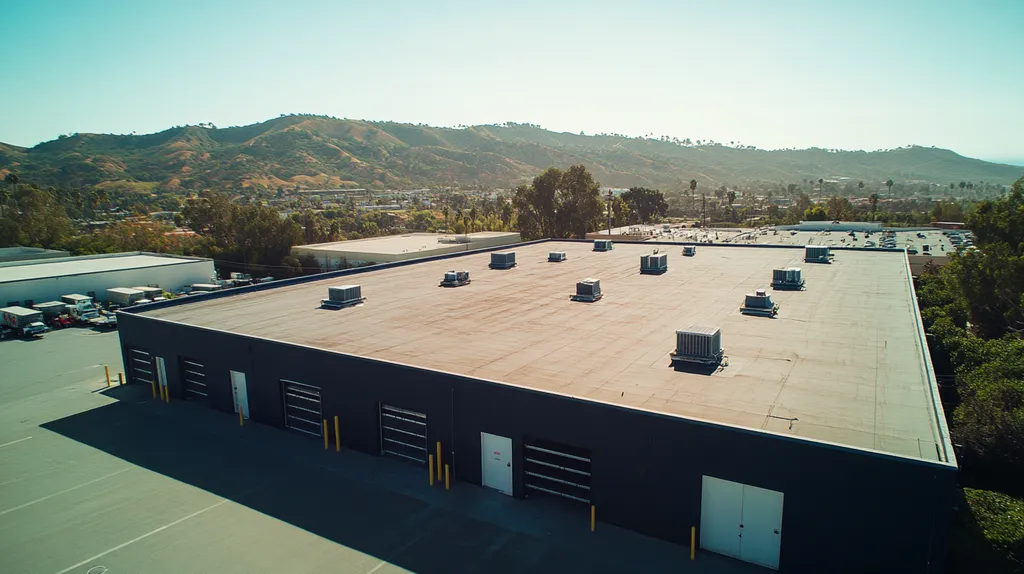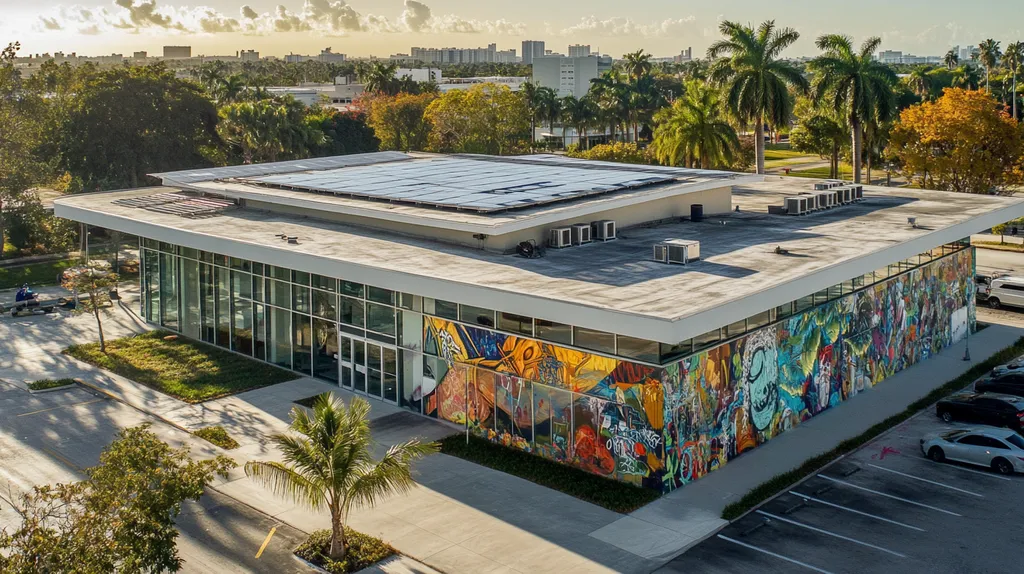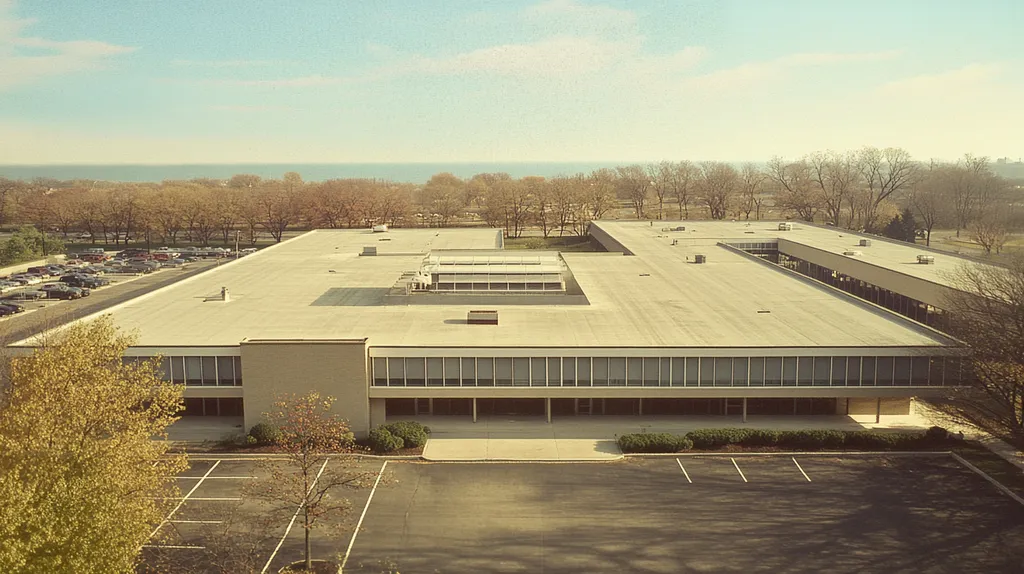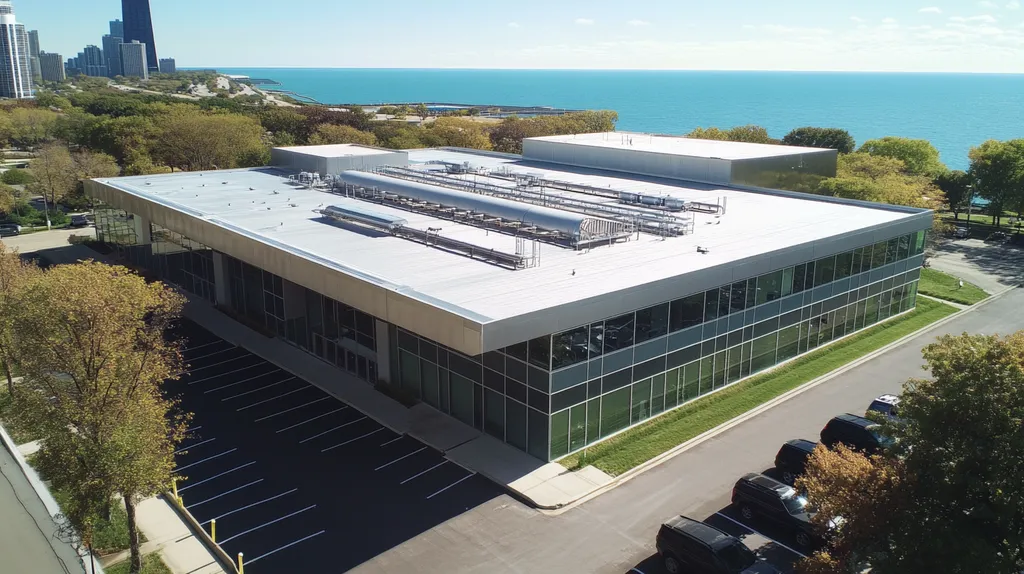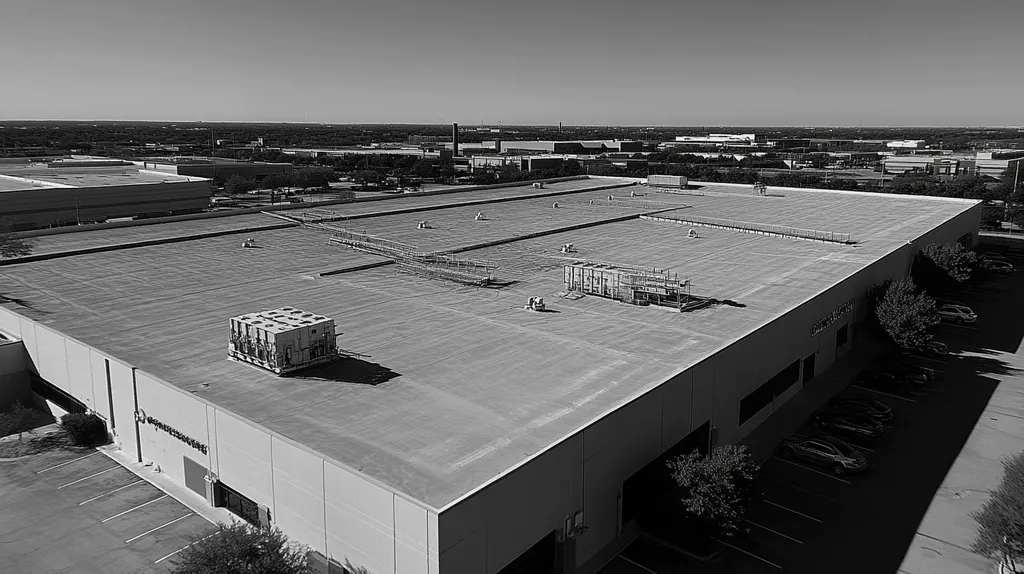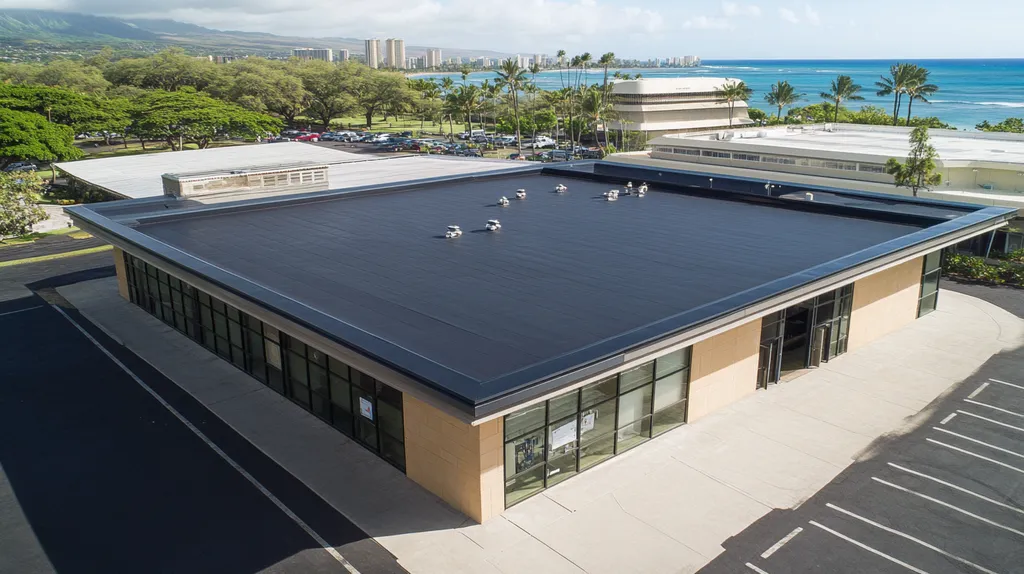In commercial roofing operations, overlooking worker safety feedback leads to devastating consequences. Industry data shows that 34% of construction fatalities result from falls, with improper safety protocols being a leading contributor.
For facility managers and property owners, establishing systems to collect and implement worker safety insights is no longer optional – it’s essential for preventing accidents and maintaining regulatory compliance.
This comprehensive guide examines the critical components of an effective safety feedback system, from initial hazard assessment through ongoing performance monitoring, providing actionable steps to create safer working environments on commercial roofs.
SECTION 1: FUNDAMENTAL CONCEPTS
In the commercial roofing industry, ensuring safety is not merely a priority; it’s an absolute essential. The Occupational Safety and Health Administration (OSHA) reports that falls have been responsible for 33% of construction-related fatalities in recent years. This alarming statistic highlights the pressing need for effective safety measures on rooftops. Property owners and facility managers must become well-acquainted with potential hazards, comply with OSHA regulations, and foster a strong safety culture to safeguard workers and boost productivity.
Identifying Potential Hazards
Spotting hazards is the first critical step toward ensuring worker safety on roofs. Common risks include falls, electrocution, and slips that can lead to severe injuries. Effectively identifying these hazards is essential; it’s not just a regulatory requirement—it can save lives and minimize costly accidents.
To efficiently pinpoint dangers, regular inspections are vital. Property owners should establish a systematic way to assess roof conditions consistently. This proactive strategy enables timely identification of wear and tear, helping to avert accidents before they occur.
Moreover, involving roof workers in hazard identification can uncover hidden risks. With their firsthand experience, workers can point out subtle dangers that might elude standard inspections.
By making hazard identification a top priority, property managers can cultivate a safer working environment and strengthen trust with their roofing teams.
Understanding OSHA Regulations
Adhering to OSHA regulations is imperative for any commercial roofing operation. OSHA provides specific guidelines that dictate safe practices on roofs, ensuring worker well-being. Non-compliance can result in heavy fines and increased liability for property owners.
A key component of these regulations is the mandate for fall protection systems, which must be in place whenever workers operate at heights exceeding six feet. Grasping these requirements is crucial for developing a robust safety program.
Furthermore, regular training sessions on OSHA standards should be mandatory for all workers. This ensures everyone is aware of appropriate safety protocols, significantly reducing the likelihood of accidents stemming from a lack of knowledge about regulations.
Incorporating OSHA guidelines into everyday practices not only enhances worker safety but also shields property owners from potential legal complications.
Importance of Safety Culture
Establishing a safety-first culture is essential in any commercial roofing venture. A strong safety culture promotes open dialogue about hazards and encourages workers to express their concerns without fear. This culture of transparency can lead to significantly improved safety outcomes.
Leadership plays an indispensable role in nurturing this culture. Property owners and facility managers must demonstrate a genuine commitment to safety through consistent actions. Actively participating in safety meetings and recognizing safety accomplishments fosters a positive and motivating environment.
Additionally, valuing feedback from roofing workers in safety protocols is incredibly beneficial. When workers know their insights matter, they become more invested in adhering to safety measures, resulting in fewer accidents.
A thriving safety culture not only protects workers but also enhances overall operational efficiency, leading to better project results.
SECTION 2: SYSTEM COMPONENTS
In the world of commercial roofing, worker safety goes beyond mere regulatory compliance—it is a fundamental necessity that can drastically lower the incidence of accidents and injuries. With falls representing a staggering 34% of fatalities in the construction industry, addressing this urgent concern is paramount. Effectively integrating safety feedback from roof workers into essential safety components—such as Personal Protective Equipment (PPE), fall protection systems, and safety netting—can create a much safer working environment for everyone involved.
Personal Protective Equipment (PPE)
Personal Protective Equipment serves as the first line of defense against workplace injuries. Essential items like hard hats, gloves, and non-slip footwear are specifically designed to mitigate various hazards. For example, hard hats provide essential protection against falling objects, while safety glasses shield eyes from potentially harmful debris.
However, the true effectiveness of PPE hinges on consistent use and regular maintenance. Surveys indicate many workers fail to wear PPE due to discomfort or a lack of knowledge regarding its importance. This gap underscores the pressing need for comprehensive training programs that emphasize both proper usage and the critical role of each safety item.
To enhance consistency in PPE usage, employers should actively involve workers in selecting their gear, fostering a sense of ownership and comfort. When employees have a say in their protective equipment, they are more likely to wear it diligently, reducing overall risk and benefiting both employees and the organization as a whole.
Additionally, continuous evaluation of PPE effectiveness can lead to advancements in safety gear. As materials and technologies improve, so too should the equipment in use, ensuring that it remains capable of meeting the evolving demands of roofing tasks.
Fall Protection Systems
Implementing fall protection systems is crucial for minimizing the risk of falls from heights. Common solutions include guardrails, personal fall arrest systems, and safety harnesses, each tailored to different roofing scenarios. Properly deployed, these systems can significantly mitigate the dangers workers face on rooftops.
Despite their critical nature, many workplaces lack a thorough fall protection strategy. For instance, it’s not uncommon for workers to have access to harnesses without adequate training on their use. Implementing proper education and hands-on training regarding fall protection systems can dramatically reduce fall incidents.
Leveraging employee feedback in the design and operation of these systems fosters greater engagement and effectiveness. When workers feel their safety concerns are acknowledged, they are more likely to participate in routine system checks and maintenance, cultivating a shared culture of safety.
Regular audits of fall protection systems are essential to maintain their efficacy. Ensuring equipment remains in peak condition and adheres to current safety standards can avert potential tragedies, reinforcing the need for consistent assessment and updates.
Safety Netting and Guardrails
Safety netting and guardrails serve as essential safety features on construction sites. These systems provide a physical barrier against falls and can catch individuals if they do slip, which is especially vital in high-risk areas like roof edges and pit openings.
Unfortunately, many installations occur only as an afterthought, and insufficient maintenance can render these systems ineffective. Regular inspections of guardrails and netting are essential to identify wear and ensure they function optimally, as neglecting maintenance significantly heightens accident risks.
Involving workers in the installation and upkeep of these systems promotes a proactive safety culture. When employees see that their safety needs are prioritized, they are more inclined to report hazards and advocate for improvements, leading to a stronger safety environment.
Ultimately, investing in effective safety netting and guardrails can be life-saving. Facilities that prioritize these components not only comply with regulations but also demonstrate a commitment to protecting their workforce, enhancing their overall reputation in the competitive roofing industry.
SECTION 3: IMPLEMENTATION METHODS
Integrating safety feedback from commercial roof workers is not just beneficial; it is essential for reducing workplace accidents and fostering team cohesion. With falls accounting for approximately 34% of all construction-related fatalities, prioritizing safety measures can profoundly impact both employee well-being and company performance. This section highlights critical methods for incorporating feedback, including conducting initial safety assessments, implementing comprehensive safety training, and establishing effective communication protocols.
Conducting Initial Safety Assessments
Initial safety assessments are vital for uncovering potential hazards before roofing work begins. These assessments should include detailed inspections of the job site, focusing on risks like edge vulnerabilities and equipment integrity. By involving roof workers in this process, property owners gain invaluable insights into the unique challenges workers encounter daily.
It is essential for property owners to made frequent safety assessments a priority, scheduling them regularly and after any substantial changes to the work environment. This proactive stance cultivates a safety-driven culture where workers feel confident voicing their concerns. Over time, this practice significantly reduces workplace incidents.
Additionally, documenting safety findings and actions taken is crucial. This not only bolsters compliance with safety regulations but also provides a database for future assessments. Consistency in these evaluations leads to ongoing improvements and adjustments informed by actual worker feedback.
Ultimately, integrating worker insights during initial safety assessments lays a strong foundation for a safety-oriented culture in roofing operations. This involvement leads to more effective mitigation strategies that account for real-world conditions from the very start.
Implementing Comprehensive Safety Training
Comprehensive safety training is imperative for preparing roof workers to operate safely. Tailoring training to the specific challenges and hazards of commercial roofing ensures that crucial nuances aren’t overlooked. A generic training program often fails to address the realities of the job.
Using interactive training methods, such as hands-on demonstrations and scenario-based exercises, greatly enhances knowledge retention. By practicing real-life situations, workers are better equipped to respond to emergencies. Regular refresher courses should also be scheduled, reinforcing the importance of safety over time.
Soliciting feedback after training sessions is key. Workers should have the opportunity to discuss what aspects were helpful and what areas could be improved. This continuous feedback loop allows for more relevant training content, making workers feel their voices have a direct impact on their safety.
In this way, a robust training program signals to workers that their safety is a priority. When workers feel well-trained and confident in handling risks, overall safety improves, leading to higher productivity and a reduction in incidents.
Establishing Communication Protocols
Effective communication protocols are essential for maintaining a responsive and safe roofing environment. Workers should have reliable channels for reporting safety concerns without fear of repercussions. Providing options for anonymous reporting can encourage more open communication.
Regular safety meetings can further facilitate dialogue between team members and management. These gatherings should focus on recent safety incidents, lessons learned, and feedback gathered from workers. This collective approach cultivates a sense of community and shared responsibility regarding safety.
Utilizing technology, such as mobile apps or communication platforms, can streamline this feedback process. Workers can conveniently report concerns or suggestions in real time, ensuring their voices are heard. This not only enhances safety but also contributes to increased job satisfaction among employees.
By establishing robust communication protocols, organizations can create a feedback loop that drives continuous improvement in safety practices. A culture of open communication leads to a safer work environment and significantly reduces risks on the job site.
SECTION 4: MAINTENANCE REQUIREMENTS
Worker safety on commercial roofs hinges on a proactive maintenance strategy. Neglecting essential maintenance not only increases the risk of accidents but can also result in overwhelming liability costs for property owners. Regular inspections and assessments can proactively identify hazards and ensure that safety protocols stay effective. This section outlines three critical maintenance areas: regular equipment inspection, maintenance of fall protection gear, and scheduling safety audits.
Regular Equipment Inspection
Regular inspections of roofing equipment are vital to creating a safe work environment. Tools like ladders, scaffolding, and harnesses require frequent checks to spot wear and tear. OSHA emphasizes the importance of routine inspections to catch potential hazards before they escalate.
For instance, a worn-out harness may fail to protect a worker during a fall. By incorporating feedback from workers about equipment concerns, property owners can prioritize which items require more frequent inspections, effectively saving costs long-term.
Creating a detailed inspection checklist can make the process more efficient. Utilizing visual aids and ensuring all team members know what to examine fosters greater accountability among workers.
Documenting these inspections provides solid proof of compliance, which is essential during safety audits. Owners and managers who prioritize regular inspections not only enhance worker safety but also safeguard their investments.
Maintenance of Fall Protection Gear
Fall protection systems are indispensable for preventing accidents in commercial roofing. Regular maintenance of both individual components and entire systems is necessary for optimal performance. Rigging, anchors, and harnesses must be routinely checked for signs of wear or damage.
Adhering to the manufacturer’s maintenance guidelines is critical. Neglecting these can void warranties and jeopardize equipment reliability when it matters most. Involving worker feedback can shed light on common issues they’ve experienced, allowing teams to address them effectively.
Training workers on the proper care and inspection of their gear fosters a safety-first mindset. When workers take part in maintaining their equipment, they feel more invested in their own safety and that of their colleagues.
Maintaining a log of these activities can help create a regular schedule for updates. This proactive approach significantly diminishes the likelihood of accidents stemming from faulty or outdated equipment.
Scheduling Safety Audits
Regular safety audits are a pillar of an effective safety program. These audits enable comprehensive evaluations of safety protocols and equipment, providing a structured way to incorporate worker feedback into everyday practices.
Audits should occur regularly and following any incidents that raise safety flags. This ensures that processes are continually improved, leveraging real-world data instead of mere assumptions. Establishing a clear audit schedule puts safety front and center.
Engaging a diverse group during audits, including roof workers and management, fosters open dialogue about safety enhancements. This collaborative approach helps build a strong safety culture throughout the organization.
Documentation from safety audits not only refines safety measures but also serves as critical evidence that safety standards are met. As industry best practices evolve, regular audits will ensure that safety protocols remain both compliant and effective.
SECTION 5: PERFORMANCE METRICS
In commercial roofing, safety metrics are far more than mere numbers; they are vital indicators of an operation’s overall effectiveness. The Occupational Safety and Health Administration (OSHA) reveals that falls account for a staggering 33% of construction-related fatalities. Recognizing and addressing these metrics is essential; neglecting them can lead to increased accidents, hefty legal penalties, and long-lasting damage to a company’s reputation. By actively tracking performance metrics, businesses can create safer working conditions, enhance training programs, and better protect their workers on roofs.
Tracking Accident and Injury Rates
Consistently tracking accident and injury rates is critical for any commercial roofing operation. Employers who regularly review these statistics can pinpoint patterns and trends that signal potential safety hazards. For instance, a spike in fall incidents emphasizes an urgent need for targeted fall protection training in the workforce.
Moreover, comparing injury rates across different projects allows facility managers to evaluate the effectiveness of their safety measures. A steady upward trend flags the necessity for immediate action and reassessment of existing safety protocols. Overlooking these metrics risks repeating dangerous mistakes that endanger workers.
Employers should utilize incident rate calculations like Total Recordable Incident Rate (TRIR) to benchmark their performance against industry standards. This practice not only reveals areas for improvement but also helps in implementing effective safety strategies tailored to specific issues.
Encouraging transparent discussions about accident statistics fosters an environment of accountability. When workers are informed about safety data, they are more likely to engage in proactive safety practices and report unsafe conditions, ultimately enhancing the safety culture on-site.
Conducting Emergency Response Drills
In preparing roofing workers for unforeseen emergencies, conducting regular emergency response drills is indispensable. Studies from the National Institute for Occupational Safety and Health (NIOSH) confirm that well-executed drills significantly lower injury rates during actual crises. These exercises help crew members understand their roles and responses in a variety of scenarios.
Emergency drills should cover a range of situations, including severe weather events, falls, and equipment malfunctions. Practicing these scenarios equips workers with hands-on experience, boosting their confidence to respond quickly and effectively when urgent issues arise.
Gathering feedback from participants after each drill is crucial for continuous improvement. Insights gained can lead to refined procedures and highlight any gaps in training or teamwork, cultivating a culture where safety is at the forefront of everyone’s mind.
Post-drill evaluations further reinforce preparedness, allowing for reviews of each drill’s effectiveness, which can result in updated safety practices that enhance the overall safety strategy on the roof.
Evaluating Safety Compliance
Regular evaluation of safety compliance is essential for mitigating accidents and upholding high safety standards. Conducting consistent audits on safety practices and equipment ensures that roofing operations comply with OSHA regulations and industry guidelines. Failing to maintain compliance can expose property owners to heavy fines and increased liability.
Employing checklists and compliance software can simplify the evaluation process, making it easier to identify areas needing improvement. Routine inspections of safety equipment, training records, and work practices should be standard practice, ensuring any issues are resolved before they escalate into accidents.
Involving workers in compliance evaluations not only increases buy-in but also fosters accountability. Workers can provide insights on safety equipment and practices that management might overlook, fortifying a culture of safety where adherence to regulations is celebrated.
Ultimately, consistent evaluation of safety compliance verifies the effectiveness of safety measures. It communicates to workers and facility managers that safety is prioritized, which can dramatically decrease the likelihood of accidents on commercial roofing projects.
SECTION 5: PERFORMANCE METRICS
In the fast-paced world of commercial roofing, safety metrics serve as essential benchmarks for operational success. The Occupational Safety and Health Administration (OSHA) highlights that falls account for an alarming 33% of fatalities in construction. This stark reality underscores the importance of actively monitoring safety metrics; overlooking them can lead to higher accident rates, severe legal repercussions, and lasting harm to a company’s reputation. By tracking these performance metrics, organizations create safer workplaces, enhance training initiatives, and ultimately better protect their employees.
Tracking Accident and Injury Rates
Regular monitoring of accident and injury rates is crucial for any commercial roofing operation. By analyzing these statistics, employers can spot patterns and trends that reveal potential safety hazards. For example, an uptick in reported falls is a clear signal for implementing targeted fall protection training.
Moreover, contrasting injury rates across different projects gives facility managers insight into the effectiveness of their safety measures. If they observe a consistent rise in injuries, it prompts immediate reassessment of existing safety protocols. Ignoring these vital metrics risks repeating past mistakes and jeopardizing worker safety.
Employers should utilize incident rate calculations, such as the Total Recordable Incident Rate (TRIR), to set performance benchmarks against industry standards. This approach not only identifies areas needing improvement but also facilitates the development of tailored safety strategies.
Openly sharing accident statistics with workers creates a culture of transparency and accountability. When team members understand safety data, they are more likely to participate in proactive safety measures and report unsafe conditions, ultimately fostering an enhanced safety culture on-site.
Conducting Emergency Response Drills
Regularly conducting emergency response drills is vital for preparing roofing workers for unexpected accidents. Research from the National Institute for Occupational Safety and Health (NIOSH) indicates that well-executed drills lead to significantly lower injury rates during real emergencies. These exercises ensure that crew members are clear about their roles and responsibilities in a crisis.
Effective drills should cover a range of emergency scenarios, including severe weather events, falls, and equipment failures. Practicing these situations gives workers critical hands-on experience, building their confidence to respond swiftly and effectively when urgent issues arise.
Collecting feedback from participants post-drill is essential for continuous improvement. Insights gleaned can refine procedures and pinpoint gaps in training or teamwork. This feedback loop is crucial for nurturing a culture where safety is prioritized, and everyone is prepared for emergencies.
Additionally, conducting thorough evaluations after each drill reinforces the significance of preparedness. Adjusting safety protocols based on drill outcomes leads to increased overall safety effectiveness on the roof.
Evaluating Safety Compliance
Systematic evaluation of safety compliance is essential for reducing accidents and sustaining high safety standards. Regular safety audits and equipment checks ensure that roofing operations align with OSHA regulations and industry practices. Non-compliance carries the risk of hefty fines and increased liability for property owners.
Utilizing checklists and compliance software simplifies the evaluation process, helping to quickly identify areas needing attention. Routine inspections of safety equipment, training records, and current work practices should be standard procedure. Taking a proactive stance allows roofing companies to address potential issues before they escalate into accidents.
Involving workers in compliance evaluations not only increases engagement but also promotes accountability. Employees can offer valuable insights on safety practices and equipment that management may overlook, thereby reinforcing a culture of safety that values adherence to regulations.
Ultimately, consistent evaluations of safety compliance ensure that safety measures remain effective, demonstrating to workers and facility managers alike that safety is a paramount concern. This commitment to safety significantly reduces the likelihood of accidents on commercial roofing projects.
Moving Forward
The stakes for implementing robust safety feedback systems in commercial roofing have never been higher, with fall-related incidents accounting for over one-third of construction fatalities annually.
Property owners and facility managers who fail to systematically collect and act on worker safety input face increased liability, regulatory penalties, and preventable accidents.
By establishing clear protocols for safety feedback, maintaining rigorous equipment inspections, and tracking key performance metrics, organizations can create a culture where worker insights drive continuous safety improvements.
The future of commercial roofing safety depends on this collaborative approach, where worker feedback becomes an integral part of safety protocols rather than an afterthought.
The cost of inaction – in both human and financial terms – makes implementing these systems not just advisable, but essential for modern roofing operations.
FREQUENTLY ASKED QUESTIONS
Q. Why is safety feedback from commercial roof workers important?
A. Safety feedback is crucial as it helps identify hidden hazards that standard inspections may miss. Workers, being on the frontlines, have firsthand experience with risks, allowing for more effective strategies to enhance safety. This collaboration builds a safety culture that prioritizes everyone’s well-being on the job.
Q. How does OSHA influence safety measures in industrial roofing?
A. OSHA establishes mandatory safety guidelines that must be followed to protect workers. These regulations emphasize fall protection, proper training, and equipment maintenance, which are essential in any industrial roofing project. Compliance not only enhances employee safety but also protects property owners from legal liabilities.
Q. What role does a safety culture play in commercial roofing?
A. A robust safety culture encourages open communication about risks and empowers workers to share their concerns. When management actively promotes safety, employees feel valued and more motivated to follow protocols, ultimately leading to a safer work environment and improved productivity.
Q. How can regular inspections improve commercial roof safety?
A. Regular inspections help identify wear and tear on equipment, ensuring that all safety measures are effective. By routinely assessing roof conditions, property owners can catch potential hazards early, significantly reducing the likelihood of accidents and fostering a culture of proactive safety in the workplace.
Q. What are key metrics to track for roofing safety performance?
A. Tracking metrics like accident and injury rates is essential for identifying trends and risks. Utilizing calculations such as Total Recordable Incident Rate (TRIR) helps benchmark performance against industry standards. This data-driven approach enables property managers to improve safety measures and enhance overall worker protection.
Q. How can we effectively implement safety training for roof workers?
A. Effective training should be tailored to specific hazards encountered in roofing. Utilizing hands-on demonstrations and scenario-based exercises enhances knowledge retention. Additionally, solicit feedback from workers after training to refine future sessions and ensure they are impactful and relevant, demonstrating that their safety is a priority.
Q. What additional resources are available for commercial roof safety?
A. Numerous resources exist, including OSHA guidelines, industry training programs, and safety associations. Websites and publications dedicated to roofing safety often provide valuable information on best practices. Networking with other professionals in the field can also yield insights and updates on efficient safety protocols to implement.

